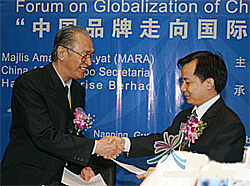
Chinese enterprises, and chambers of trade and commerce should improve their strategies to tap further into the ASEAN (Association of Southeast Asian Nations) market.
They should also take full advantage of preferential policies in the China-ASEAN free trade area (FTA) to expand trade.
This was suggested by Xu Ningning, director of the China-ASEAN Business Council, during the on-going 2nd China-ASEAN Business & Investment Summit, which is being held in Nanning, capital of the Guangxi Zhuang Autonomous Region.
China and ASEAN are hoping to establish a FTA by 2010, and will reduce export tariffs step by step until then.
"Chinese enterprises are not as familiar with the FTA framework as their ASEAN counterparts, and they are not making full use of the tariff reduction policies," Xu said.
He added that since the beginning of last year, when China signed the Early Harvest Programme with ASEAN, only 18 percent of Chinese businesses had filled in "certificates of origin" forms when exporting products to ASEAN members.
This allows them to benefit from lower tariffs when exporting. Some 60 percent of ASEAN companies take advantage of this policy.
"Most Chinese enterprises failed to enjoy this tariff cutting policy simply because they do not know about the FTA and related articles," Xu said.
The Early Harvest Programme is the first batch of tariff cutting policies developed under the framework of the China-ASEAN FTA.
"Various Chinese industry chambers do not attach enough importance to the FTA," Xu said, adding that almost all of the 16 major chambers in China failed to read detailed articles about the Framework Agreement for Overall Economic Cooperation between China and ASEAN countries. They have also failed to draft strategies to tap the huge market potential.
Xu urged Chinese chambers to strengthen communication with their counterparts in ASEAN countries to provide more business opportunities for both sides.
Chen Jian, assistant minister of commerce, said the China-ASEAN FTA will be the first of its kind for both sides.
"This is a huge market, with 1.85 billion consumers and a combined GDP of almost US$2.5 trillion. Both sides are dependent on each other, and benefit from each other's economic development," Chen said.
He said China and ASEAN can cooperate in areas such as agriculture, information technology and tourism.
China and ASEAN began the second round of tariff reduction programs this July. Under the agreement, China and six ASEAN countries gave tariff cuts to each other or lifted tariffs on more than 7,000 kinds of commodities.
(China Daily October 21, 2005)
|

